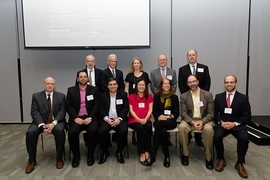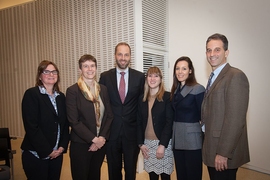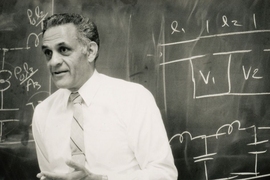Eight MIT faculty members have been awarded one of the Institute’s most respected honors: the Professor Amar G. Bose Research Grant, which supports work that is unorthodox, and potentially world-changing. The topics of the grants range from nanoscale textiles that purify drinking water, to revolutionary new approaches in catalysis, high-speed logic, and drug delivery.
The awards are named for the late Amar G. Bose ’51, SM ’52, ScD ’56, a longtime MIT faculty member and the founder of the Bose Corporation. The Bose Research Fellows for 2018 are Dirk Englund, Laura L. Kiessling, Leonid S. Levitov, Nuno F. Loureiro, Elizabeth M. Nolan, Julia Ortony, Katharina Ribbeck, and Yuriy Román. Each of this year’s grants reflects the innovative thinking, intellectually adventurous spirit, curiosity, and enthusiasm that characterize the Bose grant program. They also embody the value and practice of interdisciplinary collaboration at MIT, which drives discovery and expands the intellectual horizons of individual researchers, their colleagues, and their students.
An awards ceremony was hosted by MIT President L. Rafael Reif, and the awards were presented by MIT Provost Martin Schmidt, the Ray and Maria Stata Professor of Electrical Engineering and Computer Science. The fellows provided updates on their ongoing work at the ceremony.
As President Reif noted in his remarks, the 2018 awards carry special meaning, because they are the first to be awarded since the untimely passing in November of Vanu Gopal Bose ’87, SM ’94, PhD ’99, the son of Amar Bose and a member of the MIT Corporation. In his professional life and his service to MIT, Vanu Bose was a champion of innovation and supported many others in their pursuit of knowledge and discovery.
Novel electronic fluids for high-speed logic in quantum materials
Three investigators from the fields of quantum physics, quantum mechanics, and nuclear science and engineering will pool their expertise to explore the wonder material known as graphene. Graphene is an atomically thin carbon sheet possessing unique properties that have made it the subject of intense interest, particularly for its applications in electronics. One of those properties, says Leonid Levitov, professor of physics, is the behavior of electrons in graphene, which travel through this material “like free particles, along straight lines, ballistically, over enormous distances, and showing robust quantum-mechanical behavior up to room temperature.”
Dirk Englund, associate professor of electrical engineering and computer science, believes that insights gained from their study of graphene may advance the creation of a new logic device, capable of performing logic operations “many orders of magnitude faster and with much lower energy consumption” than the logic devices powering today’s electronics.
“Moore’s Law is coming to an end and really new concepts are needed [to] go beyond the traditional computer architecture,” Englund notes. “A lot of incremental paths have been explored already and they haven’t given us ... another few orders of magnitude of performance. We have to look at radically new ideas.”
Nuno Loureiro, associate professor of nuclear science and engineering, describes his role in the project as providing “a bridge between plasma physics” — his own area of expertise — “and the fluid-like dynamics of electrons in graphene.” In his discussions with Levitov, he has come to believe that “there are methods and ideas that can be ported from one system to the other.”
“That would be a wonderful outcome” says Loureiro, particularly for exploring some of the astrophysical applications of plasma research. “It’s possible that the behavior of a graphene sheet can map directly to a pair plasma, and if we know how to read that map, we [might create] the first quote-unquote pair plasma in the lab.” He credits the Bose grant for giving him a chance to pursue this unorthodox idea, and stretch beyond his own research.
“I’m reaching to something that is completely outside of my domain of expertise, and I’m going to learn a lot. I’m hoping those ideas can then be inspiring for things in my specific domain.”
Levitov also appreciates the exchange of ideas that the project will yield.
“To a theorist, this is all particularly appealing, as it provides a unique perspective on the developments in my field by connecting it to other fields and, of course, because of a possibly far-reaching outcome this collaboration can lead to.”
Controlling infections using nature’s strategies
Our bodies are home to trillions of microbes, the vast majority of which reside in the mucus that coats our respiratory tracts, digestive systems, and other bodily systems. Yet the exact functions and molecular structures of mucus remain largely a mystery. Laura Kiessling, professor of chemistry, and Katharina Ribbeck, the Hyman Career Development Professor in Biological Engineering, will use their Bose grant to explore how mucus protects against pathogens, and use that knowledge to create mimetic, bio-inspired materials.
Ribbeck compares mucus’s long, thread-like polymers to “tiny bottle brushes, and the bristles of these brushes are sugar molecules.” These glycoproteins regulate microbial physiology by suppressing harmful pathogens and supporting the body’s diverse microbiota. “It's hard to get down to a molecular-level understanding of how our bodies do that,” says Kiessling, but by fabricating bio-inspired materials, “we can alter their properties systematically, and ask those molecular questions that are much harder to investigate with natural materials.”
Ribbeck says her team will identify which glycoproteins have the most important effects. That knowledge then “will become the tools for [Kiessling], who will begin to build mimetic, synthetic versions of these molecular structures.” With the rise of antibiotic-resistant infections, they see enormous potential in disarming pathogens rather than killing them with antibiotics (thereby creating evolutionary pressure to become antibiotic-resistant). Instead, as Ribbeck puts it, they are “identifying nature’s strategies and then implementing them with creative chemistry.”
Kiessling and Ribbeck say that the Bose grant has enabled them to form a dynamic partnership, and pursue a high-risk, high-reward idea.
“As a scientist, you have your dreams, the stuff that keeps you awake at night,” says Ribbeck, and the research she will conduct with Bose grant support is one such project. “I am immensely grateful.” Kiessling is also excited to work on a project with broad applications: “If we can change how people think about treating infectious disease, and [move] toward exploiting natural mechanisms, that could be really transformative.”
A heavy-metal Trojan horse
One of the most serious threats to human health is the lack of new antibiotics and the rise of antibiotic-resistant disease. To tackle this problem, Elizabeth Nolan, an associate professor of chemistry, will use the Bose research grant to explore the design and delivery of nontraditional antibiotics using a Trojan horse strategy that takes advantage of the mechanisms used by bacteria to obtain iron.
“Our idea is that, since these bacteria are expressing machinery that enables iron acquisition, maybe we can take advantage of that machinery as a way to target and deliver antibacterial or toxic cargo, in a species- or strain-selective manner.” The Bose grant will enable her to “build upon [previous work] and start delivering nontraditional toxic cargo into the cell, masked as a beneficial iron chelator to the bacteria.”
This precision targeting could minimize the toxicity of drugs to the host, while addressing the problem of antibiotic resistance. It’s the type of unconventional approach that Nolan says can be challenging to fund with traditional sources. Gathering enough preliminary data to support the feasibility of a high-risk idea can be especially challenging, she adds.
With the Bose grant, Nolan can take that step, creating avenues for future research in her own lab as well as “tremendous opportunity for collaboration” with researchers in other areas of inquiry. She uses the metaphor of a tree: “We need to build the trunk right now, by making the molecules, and then once we have those, we can branch off in many different directions.”
Nolan and her colleagues have been hoping to pursue these ideas for several years, and now, she says, “we can hit the ground running. I’m delighted and very grateful.”
Functional textiles for water purification
With the support of a Bose research grant, Julia Ortony, the Finmeccanica Career Development Professor of Engineering, hopes to create simple, yet powerful, nanoscale solutions to the problem of arsenic-contaminated drinking water, a threat to the health and lives of millions in Bangladesh and other parts of South Asia.
“In our lab, we design small molecules that spontaneously self-assemble in water,” says Ortony. Their goal is to match the mechanical properties of each nanostructure with particular applications. Arsenic removal requires “very high surface area to remove trace amounts of toxins, and very robust structures so that we have very little molecular exchange.”
Current methods for removing arsenic are bulky, costly, and hard to maintain. A fabric made of nanoscale fibers would provide the surface area necessary to remove arsenic and could be functionalized with a chemical to grab arsenic ions. It would be simple to distribute and use, and could even be recharged. “We could easily modify this material remove lead or other metals,” she adds.
One inspiration behind Ortony’s proposal is a solution devised for guinea worm disease, a parasitic illness spread through drinking water. This disease was eradiated with an astoundingly simple solution: filtering drinking water through nylon fabric. Though contaminants like arsenic and lead are much more complicated to remove, Ortony believes a simple, cost-effective method utilizing nanoscale fabrics is within reach.
The Bose grant has allowed her to think more expansively about her research, created exciting opportunities for her students, and enabled her to pursue a project that engages multiple disciplines, including some that are completely new to her. “You learn a lot that way. You can bring very different ideas together, and I think that’s how a lot of discoveries and inventions are made,” she says.
Breaking away from mainstream catalysis
“The Bose grant is itself like a catalyst,” says Yuriy Román, associate professor of chemical engineering. Román’s research centers on heterogeneous catalysis, with the goal of making chemical reactions faster, more stable, and more efficient. With the support of the Bose research grant, he will embark on a new exploration: the potential of electric fields to impact molecular interactions on catalytic gas-solid surfaces.
“In our lab we work on developing strategies to enable renewable energy, implement renewable chemicals and to replace critical materials, but we have never engaged in this idea of joining the fields of electrochemistry and traditional high-temperature catalysis. It’s a completely new direction.”
The primary aims in catalysis, Román explains, are maximizing carbon economy, minimizing reactor downtime, and maximizing stability. The use of electric fields offers “an additional handle to control the catalytic process” with a high level of precision.
Román was pleased to find the very possibility he is exploring described in papers published in the 1970s by Constantinos G. Vayenas, a former professor of chemical engineering at MIT. By using today’s cutting-edge tools to examine the phenomena that Vayenas observed, Román and his team can expand Vayenas’s work, while adding new insights of their own.
While research into the unknown is a bit unnerving, Román says it also “reignites excitement” for discovery for everyone in the lab. He is grateful for the generosity of the Bose family and for the example of Professor Amar Bose, whose wide-ranging contributions and fearless spirit are inspiring. “I'm very happy that we might continue his legacy in some way.”












